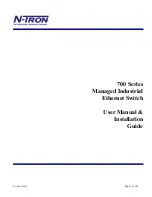
Figure 9-4
Last network bridge address table
RouterA
Port3
Port4
Port1
Port2
MAC address
Port
00e0:fcaa:aaaa
port1
00e0:fcaa:bbbb
port2
00e0:fcaa:cccc
port3
00e0:fcaa:dddd
port4
LAN1
PC 2
LAN1
PC 1
PC 3
LAN2
PC 4
LAN2
If a MAC address establishes a mapping relationship with more than one interface, the more
recent mapping relationship overrides the earlier one. This ensures each MAC address is related
with only one outbound interface.
The transparent bridge can perform dynamic MAC address learning. Learned MAC address
entries are deleted when their aging time expires.
Packet Processing
The transparent bridge processes received data frames in either of the following modes:
l
Unicast frame
If the received data frame's destination MAC address can be found in the forwarding table,
and the inbound and outbound interfaces of the frame are different, the outbound interface
forwards the data frame.
l
Broadcast
If the received data frame's destination MAC address is a unicast MAC address and cannot
be found in the forwarding table, or the destination MAC address of the data frame is a
multicast or broadcast MAC address, the data frame is forwarded using any interface of
one bridge group, and not the frame's inbound interface.
9.2.2 Local Bridging
Local bridging is the basic function of transparent bridging. As shown in
, LAN 1
and LAN 2 are in the same geographic location and need to communicate with each other at the
link layer. Transparent bridging can be used to bridge these LANs locally.
Huawei AR530&AR550 Series Industrial Switch Routers
Configuration Guide - Ethernet Switching
9 Transparent Bridging Configuration
Issue 01 (2014-11-30)
Huawei Proprietary and Confidential
Copyright © Huawei Technologies Co., Ltd.
350
















































